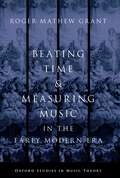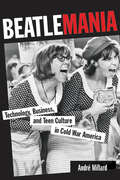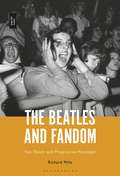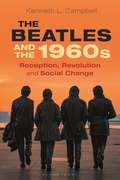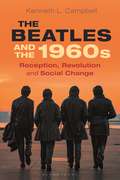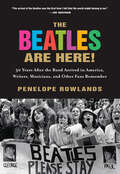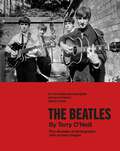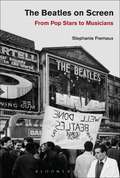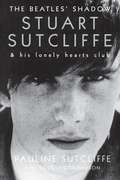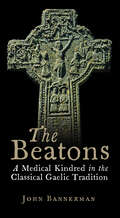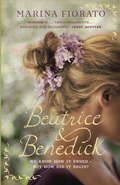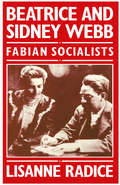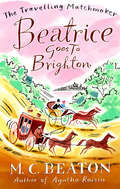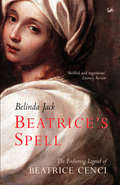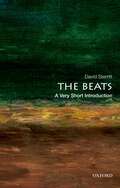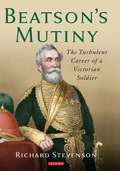- Table View
- List View
Beating the Bear: Lessons from the 1929 Crash Applied to Today's World
by Harold Bierman Jr.This book reexamines the economic crash of 1929 and compares the event to the modern stock market crash of 2008-2009.Twice in the last century the usually stalwart economy of United States has crumbled—first in 1929, when the stock market crash that led to the Great Depression hit, and again with the financial market meltdown of 2008-2009 that is still crippling much of America. While it is still too soon to state unequivocally how this latest economic disaster came about, it is possible to theorize that much of what has happened could have been foreseen and even avoided—just as it could have been in 1929. This book accurately describes the economic situations in the United States before the 1929 and 2008-2009 stock market crashes, and carefully examines the causes of both financial crises. This comprehensive assessment of both time periods allows readers to better grasp the present market situation, understand the connection between the explosion of the sub-prime mortgage market and the current state of the economy, and more wisely forecast the future.
Beating Time and Measuring Music in the Early Modern Era (Oxford Studies in Music Theory)
by Roger Mathew GrantBeating Time & Measuring Music in the Early Modern Era chronicles the shifting relationships between ideas about time in music and science from the sixteenth through the early nineteenth centuries. Centered on theories of musical meter, the book investigates the interdependence between theories of meter and conceptualizations of time from the age of Zarlino to the invention of the metronome. These formulations have evolved throughout the history of Western music, reflecting fundamental reevaluations not only of music but also of time itself. Drawing on paradigms from the history of science and technology and the history of philosophy, author Roger Mathew Grant illustrates ways in which theories of meter and time, informed by one another, have manifested themselves in the field of music. During the long eighteenth century, treatises on subjects such as aesthetics, music theory, mathematics, and natural philosophy began to reflect an understanding of time as an absolute quantity, independent of events. This gradual but conclusive change had a profound impact on the network of ideas connecting time, meter, character, and tempo. Investigating the impacts of this change, Grant explores the timekeeping techniques - musical and otherwise - that implemented this conceptual shift, both technologically and materially. Bringing together diverse strands of thought in a broader intellectual history of temporality, Grant's study fills an unexpected yet conspicuous gap in the history of music theory, and is essential reading for music theorists and composers as well as historical musicologists and practitioners of historically informed performance.
Beatlemania: Technology, Business, and Teen Culture in Cold War America (Johns Hopkins Introductory Studies in the History of Technology)
by André MillardThe fame, talent, and success of the Beatles need no introduction. Nor does the world need another book exploring the band's skill and its influence on music and society in the United States, Britain, and the rest of the world. André Millard instead studies the Beatlemania phenomenon from an original perspective—the relationship among the music business, recording technologies, and teens and young adult culture of the era. Millard argues that, despite the Beatles’ indisputable skill, they would not have attained the global recognition and been as influential without the convergence of significant developments in the way music was produced, recorded, sold, and consumed. As the Second Industrial Revolution hit full swing and baby boomers came of age, the reel-to-reel recorder and other technological advances sped the evolution of the music business. Musicians, recording studios and record labels, and music fans used and interacted with music-making and -playing technology in new ways. Higher quality machines made listening to records and the radio an experience that one could easily share with others, even if they weren’t in the same physical space. At the same time, an increase in cross-Atlantic commerce—especially of entertainment products—led to a freer exchange of ideas and styles of expression, notably among the middle and lower classes in the U.S. and the UK. At that point, Millard argues, the Beatles rode their remarkable musicianship and cultural savvy to an unprecedented bond with their fans—and spawned Beatlemania. Refreshing and insightful, Beatlemania offers a deeper understanding the days of the Fab Four and the band’s long-term effects on the business and culture of pop music.
Beatlemania in America: Fan Culture from Below
by Andrew HuntWhen The Beatles arrived in postwar America, Beatlemania swept the nation as hysterical girls flocked to the band and young men grew out their hair. In this book Andrew Hunt explores this wildly enthusiastic fandom from the bottom-up. Showcasing oral histories, fan magazines, club newsletters, newspapers and personal memoirs, he uncovers The Beatles' fan culture from the perspective of Beatlemaniacs, Beatlephobes and ordinary Americans to understand the impact it had on society at large. Offering a cultural history from below, Beatlemania in America highlights previously neglected voices of fans, critics, parents, teachers and politicians. It contextualises the Beatles fandom against a wider, global perspective of changing cultures and shows how this band was part of a wider shift of social change. It delves into who Beatles fans were and shows how their collective voice gave them power. Exploring themes of gender and race in this turbulent and tumultuous era of American history, it highlights the social issues and debates provoked by this subculture which foreshadowed the arrival of an increasingly polarized society.
Beatlemania in America: Fan Culture from Below
by Andrew HuntWhen The Beatles arrived in postwar America, Beatlemania swept the nation as hysterical girls flocked to the band and young men grew out their hair. In this book Andrew Hunt explores this wildly enthusiastic fandom from the bottom-up. Showcasing oral histories, fan magazines, club newsletters, newspapers and personal memoirs, he uncovers The Beatles' fan culture from the perspective of Beatlemaniacs, Beatlephobes and ordinary Americans to understand the impact it had on society at large. Offering a cultural history from below, Beatlemania in America highlights previously neglected voices of fans, critics, parents, teachers and politicians. It contextualises the Beatles fandom against a wider, global perspective of changing cultures and shows how this band was part of a wider shift of social change. It delves into who Beatles fans were and shows how their collective voice gave them power. Exploring themes of gender and race in this turbulent and tumultuous era of American history, it highlights the social issues and debates provoked by this subculture which foreshadowed the arrival of an increasingly polarized society.
The Beatles and Fandom: Sex, Death and Progressive Nostalgia
by Richard MillsSex, death and nostalgia are among the impulses driving Beatles fandom: the metaphorical death of the Beatles after their break-up in 1970 has fueled the progressive nostalgia of fan conventions for 48 years; the death of John Lennon and George Harrison has added pathos and drama to the Beatles' story; Beatles Monthly predicated on the Beatles' good looks and the letters page was a forum for euphemistically expressed sexuality. The Beatles and Fandom is the first book to discuss these fan subcultures. It combines academic theory on fandom with compelling original research material to tell an alternative history of the Beatles phenomenon: a fans' history of the Beatles that runs concurrently with the popular story we all know.
The Beatles and Fandom: Sex, Death and Progressive Nostalgia
by Richard MillsSex, death and nostalgia are among the impulses driving Beatles fandom: the metaphorical death of the Beatles after their break-up in 1970 has fueled the progressive nostalgia of fan conventions for 48 years; the death of John Lennon and George Harrison has added pathos and drama to the Beatles' story; Beatles Monthly predicated on the Beatles' good looks and the letters page was a forum for euphemistically expressed sexuality. The Beatles and Fandom is the first book to discuss these fan subcultures. It combines academic theory on fandom with compelling original research material to tell an alternative history of the Beatles phenomenon: a fans' history of the Beatles that runs concurrently with the popular story we all know.
The Beatles and the 1960s: Reception, Revolution, and Social Change
by Kenneth L. CampbellThe Beatles are widely regarded as the foremost and most influential music band in history and their career has been the subject of many biographies. Yet the band's historical significance has not received sustained academic treatment to date. In The Beatles' Reception in the 1960s, Kenneth L. Campbell uses the Beatles as a lens through which to explore the sweeping, panoramic history of the social, cultural and political transformations that occurred in the 1960s. It draws on audience reception theory and untapped primary source material, including student newspapers, to understand how listeners would have interpreted the Beatles' songs and albums not only in Britain and the United States, but also globally. Taking a year-by-year approach, each chapter analyses the external influences the Beatles absorbed, consciously or unconsciously, from the culture surrounding them. Some key topics include race relations, gender dynamics, political and cultural upheavals, the Vietnam War and the evolution of rock music and popular culture. The book will also address the resurgence of the Beatles' popularity in the 1980s, as well as the relevance of The Beatles' ideals of revolutionary change to our present day.This is essential reading for anyone looking for an accessible yet rigorous study of the historical relevance of the Beatles in a crucial decade of social change.
The Beatles and the 1960s: Reception, Revolution, and Social Change
by Kenneth L. CampbellThe Beatles are widely regarded as the foremost and most influential music band in history and their career has been the subject of many biographies. Yet the band's historical significance has not received sustained academic treatment to date. In The Beatles' Reception in the 1960s, Kenneth L. Campbell uses the Beatles as a lens through which to explore the sweeping, panoramic history of the social, cultural and political transformations that occurred in the 1960s. It draws on audience reception theory and untapped primary source material, including student newspapers, to understand how listeners would have interpreted the Beatles' songs and albums not only in Britain and the United States, but also globally. Taking a year-by-year approach, each chapter analyses the external influences the Beatles absorbed, consciously or unconsciously, from the culture surrounding them. Some key topics include race relations, gender dynamics, political and cultural upheavals, the Vietnam War and the evolution of rock music and popular culture. The book will also address the resurgence of the Beatles' popularity in the 1980s, as well as the relevance of The Beatles' ideals of revolutionary change to our present day.This is essential reading for anyone looking for an accessible yet rigorous study of the historical relevance of the Beatles in a crucial decade of social change.
The Beatles Are Here!: 50 Years after the Band Arrived in America, Writers, Musicians & Other Fans Remember
by Penelope RowlandsThe arrival of the Beatles was one of those unforgettable cultural touchstones. Through the voices of those who witnessed it or were swept up in it indirectly, The Beatles Are Here! explores the emotional impact—some might call it hysteria—of the Fab Four’s February 1964 dramatic landing on our shores. Contributors, including Lisa See, Gay Talese, Renée Fleming, Roy Blount, Jr., and many others, describe in essays and interviews how they were inspired by the Beatles. This intimate and entertaining collection arose from writer Penelope Rowlands’s own Beatlemaniac phase: she was one of the screaming girls captured in an iconic photograph that has since been published around the world—and is displayed on the cover of this book. The stories of these girls, who found each other again almost 50 years later, are part of this volume as well. The Beatles Are Here! gets to the heart of why, half a century later, the Beatles still matter to us so deeply.
The Beatles by Terry O'Neill: Five decades of photographs, with unseen images
by Terry O'Neill'An incredible photographer and good friend' -RINGO STARR The definitive collection of the breathtaking Beatles photographs of Terry O'Neill.Iconic photographer Terry O'Neill worked with the Beatles across five decades, capturing the band at the beginning of their rise to the top and the solo years beyond.From recording sessions, rehearsals and larking around town at the height of Beatlemania, to intimate shots at weddings, at home and on tour in the solo years after the band had split, O'Neill captured countless photographs – many of which are being published for the very first time here.With more than 300 photographs and including quotes from Terry collecting his personal memories of working with the band, The Beatles by Terry O'Neill is a unique visual portrait of the story of John, Paul, George, Ringo and the music they made.
The Beatles on Screen: From Pop Stars to Musicians
by Stephanie FremauxThe 1960s ushered in a time of creative freedom and idealism reflected in the popular music and films on both sides of the Atlantic. At the forefront of driving that creative change were four mop-topped musicians from Liverpool, The Beatles. While many scholars have examined their role as songwriters, as countercultural and political figures, and as solo artists, few have considered the important role film played in The Beatles' career. This book focuses on the overlooked films the Beatles performed in from 1964 to 1970 in order to chart their journey from pop stars to musicians. Through these case studies, The Beatles on Screen uncovers how the relationship between film and pop music has changed the ways in which bands communicate with their fans.
The Beatles on Screen: From Pop Stars to Musicians
by Stephanie FremauxThe 1960s ushered in a time of creative freedom and idealism reflected in the popular music and films on both sides of the Atlantic. At the forefront of driving that creative change were four mop-topped musicians from Liverpool, The Beatles. While many scholars have examined their role as songwriters, as countercultural and political figures, and as solo artists, few have considered the important role film played in The Beatles' career. This book focuses on the overlooked films the Beatles performed in from 1964 to 1970 in order to chart their journey from pop stars to musicians. Through these case studies, The Beatles on Screen uncovers how the relationship between film and pop music has changed the ways in which bands communicate with their fans.
The Beatles' Shadow: Stuart Sutcliffe & His Lonely Hearts Club
by Pauline SutcliffeStuart Sutcliffe is the most famous contender for the crown of 'fifth Beatle'. One of the founding members, a close friend of Lennon, he left the band after their Hamburg sojourn in order to pursue his promising career as an artist, dying shortly thereafter of a brain haemorrhage. For years his sister Pauline has tried to protect his memory against the Beatles' need to sanitise their early history and now she is ready to tell the real story. In so doing she sheds new light on their formative period - the rivalry with McCartney, how George Harrison tried to keep the peace, the truth about Stuart's intense relationship with Lennon and why Lennon was haunted by guilt over her brother's death. And she describes what it was like for those like herself and Cynthia Lennon who have had no choice but to live with the Beatles all their lives. 'Gripping . . . the story of Stuart Sutcliffe. . . holds the key to the birth of pop's greatest group' Daily Mail 'An odd, fascinating book' MOJO
The Beatons: A Medical Kindred in the Classical Gaelic Tradition
by John BannermanThis book traces the Clann Meic-bethad or Clan MacBeth whose members practised medicine in the classic Gaelic tradition in various parts of Scotland from the early fourteenth to the early eighteenth century. From many medieval Gaelic manuscripts known to have been in their possession, individual members of the clan and their activities are identified. Sometime in the second half of the sixteenth century the kindred began to adopt Beaton as a surname for use in non-Gaelic contexts. The medical Beatons fell naturally into two divisions: one confined mainly to the Western Isles and the other to the mainland of Scotland. This detailed study of the Beatons and their medicine describes how the position of medical doctor was inherited by the eldest son, and potential Beaton physicians were sent out to be trained by other members of the family for several years before undertaking their own practice. The book provides information on medieval medicine at the highest levels of Highland society.
Beatrice and Benedick
by Marina FioratoHidden in the language of Shakespeare's best-loved comedy Much Ado About Nothing, are several clues to an intriguing tale. It seems that the witty lovers Beatrice and Benedick had a previous youthful love affair which ended bitterly. But how did they meet, why did they part, and what brought them together again?Messina, Sicily, 1588. Beatrice of Mantua comes to the court of her uncle Leonato, to be companion to his daughter, Hero. That fateful summer, Spanish lordling Don Pedro visits for a month-long sojourn on the island with his regiment. In his company is the young soldier Benedick of Padua.Benedick and Beatrice begin to wage their merry war of wit, which masks the reality that they dance a more serious measure, and the two are soon deeply in love. But the pair are cruelly parted by natural disaster and man-made misunderstanding. Oceans apart, divided by war and slander, Beatrice and Benedick begin their ten-year odyssey back to Messina and each other.In a journey that takes us from sunlit Sicily to the crippled Armada fleet and from ancient superstition to the glorious Renaissance cities of the north, Marina Fiorato tells a story of intrigue, treachery and betrayal that will shed a new light on Shakespeare's most appealing lovers.'Captures the scents, passion and vigour of Italy' Booklist
Beatrice Goes to Brighton: A Novel Of Regency England - Being The Fourth Volume Of The Traveling Matchmaker (The Travelling Matchmaker Series #4)
by M.C. BeatonThe fourth book in M.C. Beaton's charming Travelling Matchmaker series. The unsinkable Miss Pym returns to the English stagecoach in search of adventure and troubled hearts, and with her delightful schemes and discerning eye, she never fails to strike a match by journey's end.Lady Beatrice Marsham is in quite a coil. No sooner is she widowed from a brutish gambling husband, than her heartless family is forcing her into another horrid marriage. Fleeing by stagecoach to the Brighton seaside, the proud beauty meets Miss Hannah Pym, who is determined to find her a proper match.The handsome and kind Lord Alistair Munro would be perfect. Unfortunately, he is convinced of the ton gossip that proclaims Lady Beatrice a cruel flirt. Miss Pym, however, is not worried. The lady's hard heart has softened much since coming to Brighton. and though Lord Alistair disapproves of the old Lady Beatrice, by Miss Pym's clever design, he is sure to fall in love with the new and improved model...'Romance fans are in for a treat' - Booklist'[M. C. Beaton] is the best of the Regency writers' - Kirkus Reviews
Beatrice's Spell: The Enduring Legend of Beatrice Cenci
by Belinda JackBeatrice Cenci was executed in Rome in September 1599: she was said to be sixteen, and was hauntingly beautiful. Her crime was the murder of her father, a member of one of the greatest Roman families, but his cruel treatment of her, including incestuous rape, moved the people of the city to take her side. Weeping crowds lined the streets, and a special mass is still said in Rome on the anniversary of her death. She was at once innocent and guilty, the victim and the perpetrator of appalling crimes. From that time since, the ambivalent image of Beatrice has attracted writers and artists, and often their obsession with her fed their own self-destruction. In this compelling study, Belinda Jack takes on the dangerous challenge of bringing Beatrice to life, and of tracing her power over those who tried to resurrect her, from the tragedy of Shelley to the novels of Nathaniel Hawthorne and Herman Melville, from the sculpture of Harriet Hosmer and the photographs of Julia Margaret Cameron to the desperate drama of Antonin Artaud. As we follow the stories of their lives and ambitions, we see how they suffered critical condemnation for their works about Beatrice, and were sometimes pushed to the brink of insanity. Her story, which is one of lust, passion and violence, contains a powerful sense of the forbidden, the taboo that drives people over the edge. Beatrice's Spell is at once scholarly and utterly engrossing, carrying the power of her story through time.
Beatriz Allende: A Revolutionary Life in Cold War Latin America
by Tanya HarmerThis biography of Beatriz Allende (1942–1977)—revolutionary doctor and daughter of Chile's socialist president, Salvador Allende—portrays what it means to live, love, and fight for change. Inspired by the Cuban Revolution, Beatriz and her generation drove political campaigns, university reform, public health programs, internationalist guerrilla insurgencies, and government strategies. Centering Beatriz's life within the global contours of the Cold War era, Tanya Harmer exposes the promises and paradoxes of the revolutionary wave that swept through Latin America in the long 1960s.Drawing on exclusive access to Beatriz's private papers, as well as firsthand interviews, Harmer connects the private and political as she reveals the human dimensions of radical upheaval. Exiled to Havana after Chile's right-wing military coup, Beatriz worked tirelessly to oppose dictatorship back home. Harmer's interviews make vivid the terrible consequences of the coup for the Chilean Left, the realities of everyday life in Havana, and the unceasing demands of solidarity work that drained Beatriz and her generation of the dreams they once had. Her story demolishes the myth that women were simply extras in the story of Latin America's Left and brings home the immense cost of a revolutionary moment's demise.
The Beats: A Very Short Introduction (Very Short Introductions)
by David SterrittIn the late 1950s and early 1960s, the writers of the Beat Generation revolutionized American literature with their iconoclastic approach to language and their angry assault on the conformity and conservatism of postwar society. They and their followers took aim at the hypocrisy and taboos of their time--particularly those involving sex, race, and class--in such provocative works as Jack Kerouac's On the Road (1957), Allen Ginsberg's "Howl" (1956), and William S. Burroughs's Naked Lunch (1959). In this Very Short Introduction, David Sterritt offers a concise overview of the social, cultural, and aesthetic sensibilities of the Beats, bringing out the similarities that connected them and also the many differences that made them a loosely knit collective rather than an organized movement. Figures in the saga include Neal Cassady, Gregory Corso, Lawrence Ferlinghetti, John Clellon Holmes, Carolyn Cassady, and Gary Snyder. As Sterritt ranges from Greenwich Village and San Francisco to Mexico, western Europe, and North Africa, he sheds much light on how the Beats approached literature, drugs, sexuality, art, music, and religion. Members of the Beat Generation hoped that their radical rejection of materialism, consumerism, and regimentation would inspire others to purify their lives and souls as well. Yet they urged the remaking of consciousness on a profoundly inward-looking basis, cultivating "the unspeakable visions of the individual," in Kerouac's phrase. The idea was to revolutionize society by revolutionizing thought, not the other way around. This book explains how the Beats used their antiauthoritarian visions and radical styles to challenge dominant values, fending off absorption into mainstream culture while preparing ground for the larger, more explosive social upheavals of the 1960s. More than half a century later, the Beats' impact can still be felt in literature, cinema, music, theater, and the visual arts. This compact introduction explains why. About the Series: Oxford's Very Short Introductions series offers concise and original introductions to a wide range of subjects--from Islam to Sociology, Politics to Classics, Literary Theory to History, and Archaeology to the Bible. Not simply a textbook of definitions, each volume in this series provides trenchant and provocative--yet always balanced and complete--discussions of the central issues in a given discipline or field. Every Very Short Introduction gives a readable evolution of the subject in question, demonstrating how the subject has developed and how it has influenced society. Eventually, the series will encompass every major academic discipline, offering all students an accessible and abundant reference library. Whatever the area of study that one deems important or appealing, whatever the topic that fascinates the general reader, the Very Short Introductions series has a handy and affordable guide that will likely prove indispensable.
The Beats: A Very Short Introduction (Very Short Introductions)
by David SterrittIn the late 1950s and early 1960s, the writers of the Beat Generation revolutionized American literature with their iconoclastic approach to language and their angry assault on the conformity and conservatism of postwar society. They and their followers took aim at the hypocrisy and taboos of their time--particularly those involving sex, race, and class--in such provocative works as Jack Kerouac's On the Road (1957), Allen Ginsberg's "Howl" (1956), and William S. Burroughs's Naked Lunch (1959). In this Very Short Introduction, David Sterritt offers a concise overview of the social, cultural, and aesthetic sensibilities of the Beats, bringing out the similarities that connected them and also the many differences that made them a loosely knit collective rather than an organized movement. Figures in the saga include Neal Cassady, Gregory Corso, Lawrence Ferlinghetti, John Clellon Holmes, Carolyn Cassady, and Gary Snyder. As Sterritt ranges from Greenwich Village and San Francisco to Mexico, western Europe, and North Africa, he sheds much light on how the Beats approached literature, drugs, sexuality, art, music, and religion. Members of the Beat Generation hoped that their radical rejection of materialism, consumerism, and regimentation would inspire others to purify their lives and souls as well. Yet they urged the remaking of consciousness on a profoundly inward-looking basis, cultivating "the unspeakable visions of the individual," in Kerouac's phrase. The idea was to revolutionize society by revolutionizing thought, not the other way around. This book explains how the Beats used their antiauthoritarian visions and radical styles to challenge dominant values, fending off absorption into mainstream culture while preparing ground for the larger, more explosive social upheavals of the 1960s. More than half a century later, the Beats' impact can still be felt in literature, cinema, music, theater, and the visual arts. This compact introduction explains why. About the Series: Oxford's Very Short Introductions series offers concise and original introductions to a wide range of subjects--from Islam to Sociology, Politics to Classics, Literary Theory to History, and Archaeology to the Bible. Not simply a textbook of definitions, each volume in this series provides trenchant and provocative--yet always balanced and complete--discussions of the central issues in a given discipline or field. Every Very Short Introduction gives a readable evolution of the subject in question, demonstrating how the subject has developed and how it has influenced society. Eventually, the series will encompass every major academic discipline, offering all students an accessible and abundant reference library. Whatever the area of study that one deems important or appealing, whatever the topic that fascinates the general reader, the Very Short Introductions series has a handy and affordable guide that will likely prove indispensable.
Beatson's Mutiny: The Turbulent Career of a Victorian Soldier
by Richard StevensonOver a long and varied career, Major-General William Beatson earned a fine reputation as a leader of irregular cavalry in the nineteenth century. He trained many future commanders of the Victorian army, saw action in Spain and British India, and rode with the Heavy Brigade at the Battle of Balaklava. But tasked with disciplining the Turkish Bashi-Bazouks during the Crimean War, his character flaws led him into conflict with politicians and diplomats running the war, who accused him of inciting mutiny. Parliament, newspapers and the law courts then became his chosen battlefields as he fought to clear his name and return to duty. By bringing Beatson's life and career into sharper focus, Richard Stevenson connects wide-ranging themes in Victorian military and imperial history in a fresh and accessible way.
The Beau Monde: Fashionable Society in Georgian London
by Hannah GreigThe story of the world's first fashion-obsessed society in 18th-century London Caricatured for extravagance, vanity, glamorous celebrity and, all too often, embroiled in scandal and gossip, 18th-century London's fashionable society had a well-deserved reputation for frivolity. But to be fashionable in 1700s London meant more than simply being well dressed. Fashion denoted membership of a new type of society—the beau monde, a world where status was no longer determined by coronets and countryseats alone but by the more nebulous qualification of metropolitan 'fashion'. Conspicuous consumption and display were crucial; the right address, the right dinner guests, the right possessions, the right jewels, the right seat at the opera. The Beau Monde leads us on a tour of this exciting new world, from court and parliament to London's parks, pleasure grounds, and private homes. From brash displays of diamond jewellery to the subtle complexities of political intrigue, we see how membership of the new elite was won, maintained—and sometimes lost. On the way, we meet a rich and colourful cast of characters, from the newly ennobled peer learning the ropes and the imposter trying to gain entry by means of clever fakery, to the exile banned for sexual indiscretion. Above all, as the story unfolds, we learn that being a Fashionable was about far more than simply being 'modish'. By the end of the century, it had become nothing less than the key to power and exclusivity in a changed world.

